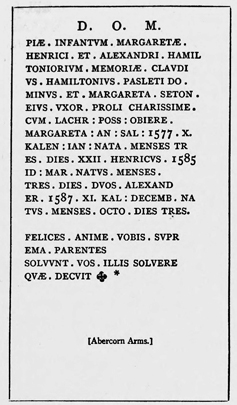Chapter XX: Remains
There is a dormitory above the chapel, arched by stone, of twelve feet in breadth by ten feet high to the keystone of the arch. The entrance is by a doorway in the middle of the south side of the arch, and the apartment is lighted by two windows—one in the east gable, and the other in the west. In the west gable there is a private stair leading from the dormitory to the chapel. The priest, who was bound by the charter to live at the chapel, doubtless occupied the sleeping place above it.
The chapel at the Reformation was converted into a family burying-place by Claud Hamilton, the Commendator. Its endowment, as we have seen, was applied to the support of a grammar school. There is a memorial of the old Commendator in a tablet erected on the north side of the chapel by him to three of his children, with the following Latin inscription

Translation :—To God the Greatest and Best.—Erected by Claud Hamilton, Lord Paisley, and Margaret Seton, his wife, with tears, to the pious memory of the infants Margaret, Henry, and Alexander Hamilton, their beloved children, who died—Margaret, on the 23d December, in the year of grace 1577, aged three months twenty-two days ; Henry, on the 15th March, 1585, aged three months two days ; Alexander, on the 21st November, 1587, aged eight months three days. Happy souls ! to you your parents pay the last rites, which ye should have paid to them.
Various members of the Abercorn family lie buried in the vault below, and the chapel belongs to the present Duke, and is under his control.[10]
The supposed tomb of Marjory Bruce, which will be noticed further on, is in the centre of the chapel. The chapel is famed for an echo, which has been noticed by every writer in succession who has described the Abbey. As early as 1774, Pennant, in his “Tour Through Scotland,” says[11]:—“The Earl of Abercorn's burial place is by much the greatest curiosity in Paisley. It is an old Gothic chapel, without pulpit or pew, or any ornament whatever ; but it has the finest echo, perhaps, in the world. When the end door (the only one it has) is shut, the noise is equal to a loud and not very distant clap of thunder ; if you strike a single note of music you hear the sound gradually ascending, till it dies away as at immense distance, and all the while diffusing itself through the circumambient air ; if a good voice sings, or a musical instrument is well played upon, the effect is inexpressibly agreeable.” This description of the echo by the famous traveller is either much exaggerated, or the strength of the echo has become diminished since his time. When any number of persons are within the building, an echo is scarcely audible at all. It is amusing sometimes to see a group of people expending the strength of their lungs in vain by attempting to evoke it.
[10] I have thought it right to say this, as during my incumbency I have received many complaints from visitors as to the state in which this chapel is kept. It is coated with common, rough whitewash. The splendid window is bricked up; the wonderful sculptures whitewashed over. The tomb of Marjory Bruce is dirty and ill-kept and scribbled upon. A smith's-shop has been built against the east end of the chapel, and a shed against the south side for keeping whiskey barrels. When so much has been done by the public to restore the other parts of the Abbey, it is a pity that this chapel should not be kept in common decency. It has been well said by the present Dean of Westminster, who visited the chapel in 1876, that “It ought to be impossible for any member of that great branch of the House of Hamilton to view with indifference the cradle of their family, from which their fortunes and their titles were derived, and in which for two centuries their ancestors resided, and found their last resting-place.” This apparent impossibility seems to have been achieved.
[11] Tour Through Scotland, by Thomas Pennant, p. 168.